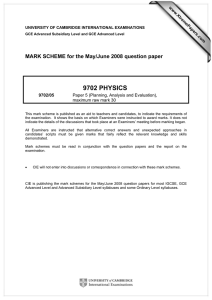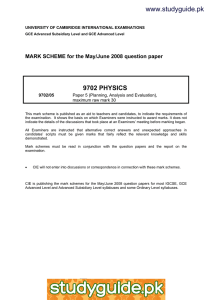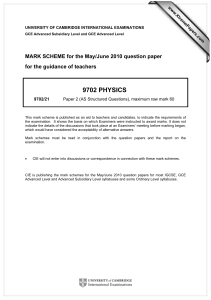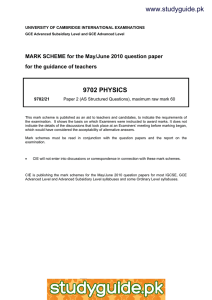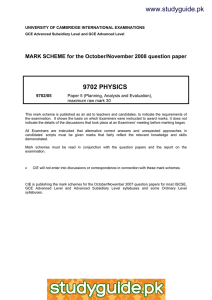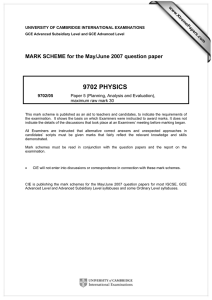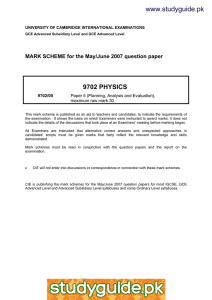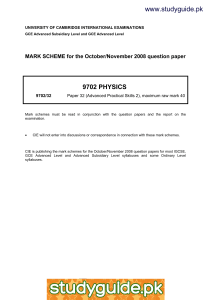9702 PHYSICS MARK SCHEME for the October/November 2008 question paper
advertisement
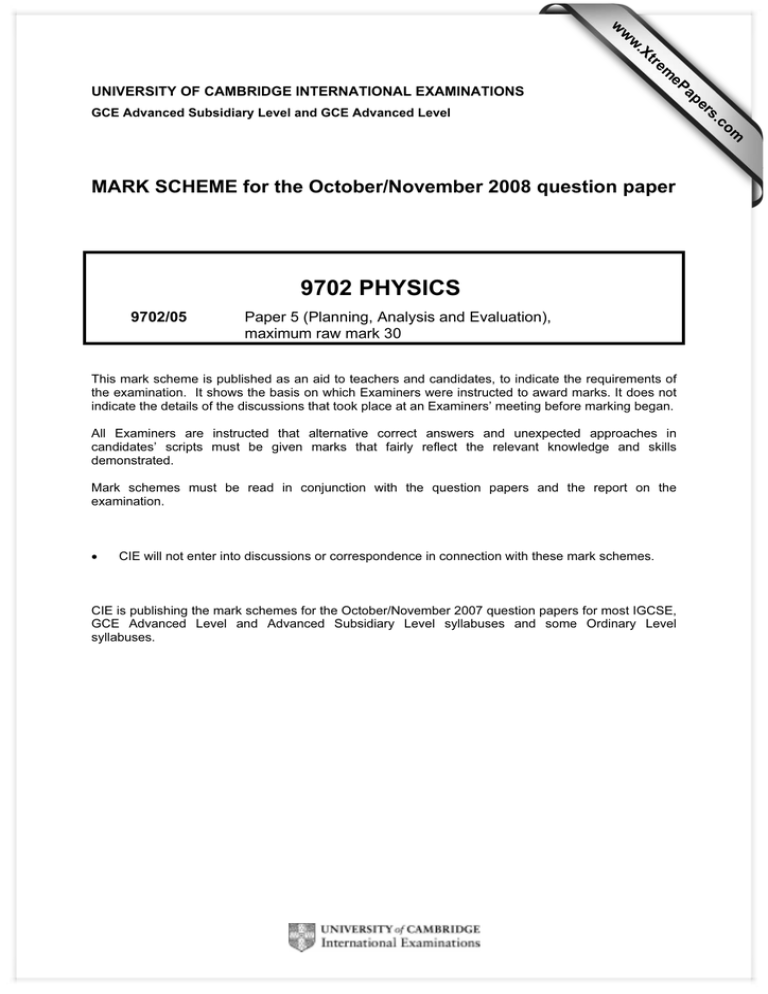
w w ap eP m e tr .X w UNIVERSITY OF CAMBRIDGE INTERNATIONAL EXAMINATIONS 9702 PHYSICS 9702/05 Paper 5 (Planning, Analysis and Evaluation), maximum raw mark 30 This mark scheme is published as an aid to teachers and candidates, to indicate the requirements of the examination. It shows the basis on which Examiners were instructed to award marks. It does not indicate the details of the discussions that took place at an Examiners’ meeting before marking began. All Examiners are instructed that alternative correct answers and unexpected approaches in candidates’ scripts must be given marks that fairly reflect the relevant knowledge and skills demonstrated. Mark schemes must be read in conjunction with the question papers and the report on the examination. • CIE will not enter into discussions or correspondence in connection with these mark schemes. CIE is publishing the mark schemes for the October/November 2007 question papers for most IGCSE, GCE Advanced Level and Advanced Subsidiary Level syllabuses and some Ordinary Level syllabuses. om .c MARK SCHEME for the October/November 2008 question paper s er GCE Advanced Subsidiary Level and GCE Advanced Level Page 2 Mark Scheme GCE A/AS LEVEL – October/November 2008 Syllabus 9702 Paper 05 Question 1 Planning (15 marks) Defining the problem (3 marks) P1 d is the independent variable or vary d (allow in table if numbers given) [1] P2 R is the dependent variable or measure R as d varied (allow in table) [1] P3 Keep output of light source constant (allow constant current / e.m.f. / voltage / power) [1] Methods of data collection (5 marks) M1 Diagram showing an LDR in a circuit and an independent lamp. [1] M2 Diagram showing ruler measuring appropriate distance or d labelled correctly. [1] M3 Correct circuit diagram for LDR using conventional symbols; allow labelled diagram Ammeter and voltmeter with power supply, or potential divider methods ohmmeter without power supply, or bridge methods. [1] M4 Method of determining R. Ohmmeter. R = V/I justified. Potential divider equation Description of balancing bridge with correct equation. [1] M5 Perform experiment in a dark room/tube [1] Method of analysis (2 marks) A1 Plot a graph of log R against log d [1] A2 Relationship is correct if log R against log d graph is a straight line [1] Safety considerations (1 mark) S1 Do not look directly at bright light source / do not touch hot light source. Allow safety glasses with reference to light source. [1] Additional detail (4 marks) D1/2/3/4 Relevant points might include [4] Detail on measuring the distance Keep orientation of LDR with respect to the light source constant Reasoned method for keeping light and LDR in correct orientation. (E.g. use of set square, fix to rule, optical bench or equivalent) Determination of a typical current Range of ammeter / ohmmeter Control (or monitoring) of an additional variable e.g. temperature Reason for performing experiment in a dark room related to the LDR Method for checking the output of the light source is constant. Identifies gradient = n and/or y-intercept = log k for log R against log d graph Do not allow parallax when reading ruler, or reflectors. [Total: 15] © UCLES 2008 Page 3 Mark Scheme GCE A/AS LEVEL – October/November 2008 Syllabus 9702 Paper 05 Question 2 Analysis, conclusions and evaluation (15 marks) Part Mark Expected Answer (a) A1 8m eB (b) T1 T2 (i) (c) (ii) (c) (iii) (d) Allow gradient = 2 4.4 or 4.41 7.8 or 7.84 12 or 11.6 (or 11.56) 15 or 15.2 (or 15.21) 18 or 18.5 (or 18.49) 22 or 22.1 (or 22.09) All values given to two or three significant figures. G1 ± 0.4 (allow ± 0.5), ± 0.6, ± 0.7, ± 0.8, ± 0.9, ± 0.9 or ± 1.0 Six points plotted correctly. E2 Error bars in d 2 plotted correctly. G2 Line of best fit. G3 Worst acceptable straight line. Steepest or shallowest possible line that passes through all the error bars. C1 Gradient of best fit line. E3 Error in gradient C2 e/m = 8/(gradient × B2) = 1.28 × 105/gradient = 1.8 × 1011 E1 (c) Additional Guidance 8 e m B2 Ignore significant figures Must be to two or three significant figures. A mixture of 2s.f. and 3s.f. is allowed. Allow more than one significant figure. Must be within half a small square. Use transparency. E.c.f. allowed from table. Check first and last point. Must be accurate within half a small square. If points are plotted correctly then lower end of line should pass between (150, 2) and (200, 2) and upper end of line should pass between (3200, 24) and (3250, 23.7). Allow e.c.f. from points plotted incorrectly – examiner judgement. Line should be clearly labelled or dashed. Should pass from top of top error bar to bottom of bottom error bar or bottom of top error bar to top of bottom error bar. Mark scored only if error bars are plotted. The triangle used should be greater than half the length of the drawn line. Check the read offs. Work to half a small square. Do not penalise POT. If points and BFL correct then gradient should be in numerical range (7.00 – 7.35) (× 10–7). Method of determining absolute error. Difference in worst gradient and gradient. Gradient must be used. Allow e.c.f. from (c) (iii) but penalise POT. E4 Method of determining error in e/m. If gradient within range given, then e/m in range (1.74 – 1.83) × 1011. Uses worst gradient and finds difference. Allow fractional error methods. Do not check calculation. C3 Unit of e/m: C kg–1. Accept V m–2 T–2. © UCLES 2008 Page 4 (e) Mark Scheme GCE A/AS LEVEL – October/November 2008 3.80 – 4.00 × 10-3 C4 [If POT in (d) allow 0.38 – 0.40] E5 Method for determining largest error in correct value of B. Syllabus 9702 Check method. B = Paper 05 8 × 500 e m × (3.8 × 10 −2 ) 2 Answer must be in range given. This mark can only be scored if B is in range. Expect to see similar calculation to above with largest e/m x (3.9 × 10–2)2 or smallest e/m x (3.7 × 10–2)2. Allow fractional error methods. [Total: 15] Uncertainties in Question 2 (c) (iii) Gradient [E3] 1. Uncertainty = gradient of line of best fit – gradient of worst acceptable line 2. Uncertainty = ½ (steepest worst line gradient – shallowest worst line gradient) (d) e/m [E4] 1. Uncertainty = e/m from gradient – e/m from worst acceptable line 2. ∆ me e m = ∆gradient gradient (e) B [E5] 1. Substitution method to find worst acceptable B using either largest e/m × (3.9 × 10–2)2 or smallest e/m × (3.7 × 10–2)2. 2. ∆B B = 1 ∆ me 2 e m + 2∆d ∆ e ∆d = m + d 2 me d © UCLES 2008 Page 5 Mark Scheme GCE A/AS LEVEL – October/November 2008 Syllabus 9702 Paper 05 Summary of shorthand notation which may be used in annotating scripts: XEX Wrong experiment SFP Significant figure penalty ECF Error carried forward AE Arithmetical error POT Power of ten error NV Not valid NR Not relevant NBL Not best line NWL Not worst line FO False origin NE Not enough NGE Not good enough BOD Benefit of the doubt NA Not allowed SV Supervisor's value SR Supervisor’s report OOR Candidate's value is out of range CON Contradictory physics not to be credited ∆ Used to show that the size of a triangle is appropriate M3 Used to show the type of mark awarded for a particular piece of work C Used to show that the raw readings are consistent SF Used to show calculated quantities have been given to an appropriate number of significant figures ^ Piece of work missing (one mark penalty) ^^ Several pieces of work missing (more than one mark penalty) ↔ Scale can be doubled in the x-direction b Scale can be doubled in the y-direction © UCLES 2008

